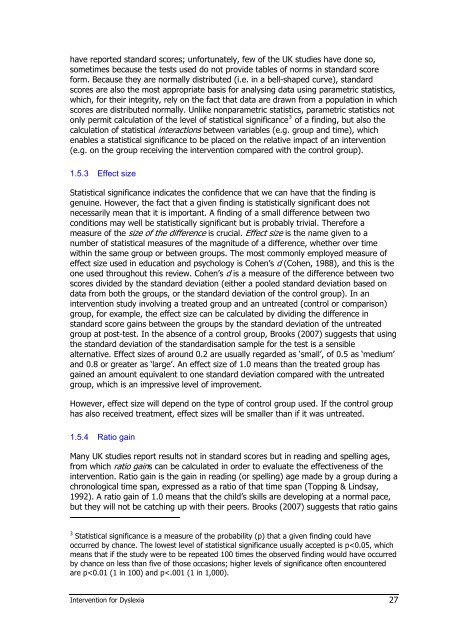Intervention for Dyslexia - The British Dyslexia Association
Intervention for Dyslexia - The British Dyslexia Association
Intervention for Dyslexia - The British Dyslexia Association
Create successful ePaper yourself
Turn your PDF publications into a flip-book with our unique Google optimized e-Paper software.
have reported standard scores; un<strong>for</strong>tunately, few of the UK studies have done so,<br />
sometimes because the tests used do not provide tables of norms in standard score<br />
<strong>for</strong>m. Because they are normally distributed (i.e. in a bell-shaped curve), standard<br />
scores are also the most appropriate basis <strong>for</strong> analysing data using parametric statistics,<br />
which, <strong>for</strong> their integrity, rely on the fact that data are drawn from a population in which<br />
scores are distributed normally. Unlike nonparametric statistics, parametric statistics not<br />
only permit calculation of the level of statistical significance 3 of a finding, but also the<br />
calculation of statistical interactions between variables (e.g. group and time), which<br />
enables a statistical significance to be placed on the relative impact of an intervention<br />
(e.g. on the group receiving the intervention compared with the control group).<br />
1.5.3 Effect size<br />
Statistical significance indicates the confidence that we can have that the finding is<br />
genuine. However, the fact that a given finding is statistically significant does not<br />
necessarily mean that it is important. A finding of a small difference between two<br />
conditions may well be statistically significant but is probably trivial. <strong>The</strong>re<strong>for</strong>e a<br />
measure of the size of the difference is crucial. Effect size is the name given to a<br />
number of statistical measures of the magnitude of a difference, whether over time<br />
within the same group or between groups. <strong>The</strong> most commonly employed measure of<br />
effect size used in education and psychology is Cohen’s d (Cohen, 1988), and this is the<br />
one used throughout this review. Cohen’s d is a measure of the difference between two<br />
scores divided by the standard deviation (either a pooled standard deviation based on<br />
data from both the groups, or the standard deviation of the control group). In an<br />
intervention study involving a treated group and an untreated (control or comparison)<br />
group, <strong>for</strong> example, the effect size can be calculated by dividing the difference in<br />
standard score gains between the groups by the standard deviation of the untreated<br />
group at post-test. In the absence of a control group, Brooks (2007) suggests that using<br />
the standard deviation of the standardisation sample <strong>for</strong> the test is a sensible<br />
alternative. Effect sizes of around 0.2 are usually regarded as ‘small’, of 0.5 as ‘medium’<br />
and 0.8 or greater as ‘large’. An effect size of 1.0 means than the treated group has<br />
gained an amount equivalent to one standard deviation compared with the untreated<br />
group, which is an impressive level of improvement.<br />
However, effect size will depend on the type of control group used. If the control group<br />
has also received treatment, effect sizes will be smaller than if it was untreated.<br />
1.5.4 Ratio gain<br />
Many UK studies report results not in standard scores but in reading and spelling ages,<br />
from which ratio gains can be calculated in order to evaluate the effectiveness of the<br />
intervention. Ratio gain is the gain in reading (or spelling) age made by a group during a<br />
chronological time span, expressed as a ratio of that time span (Topping & Lindsay,<br />
1992). A ratio gain of 1.0 means that the child’s skills are developing at a normal pace,<br />
but they will not be catching up with their peers. Brooks (2007) suggests that ratio gains<br />
3 Statistical significance is a measure of the probability (p) that a given finding could have<br />
occurred by chance. <strong>The</strong> lowest level of statistical significance usually accepted is p









